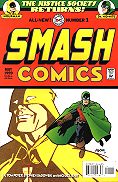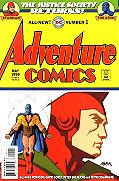 The
Justice Society Returns
The
Justice Society Returns
These issues have, subsequently, been collected in a TPB.
 The
Justice Society Returns
The
Justice Society Returns
(1999 - nine issues, published by DC Comics)
Writers: James Robinson, David Goyer, and various. Art: various.
The Justice Society Returns blended the idea of a mini-series (a finite number of issues telling a story) with the look of those "event" crossover series comics companies like so much. By that I mean that it has the look of a crossover story, in that the story begins in All-Star Comics #1, continues into a series of individually titled middle issues (Sensation Comics #1, Smash Comics #1, etc.) before concluding in All-Star Comics #2 -- all published in a single month. But the inbetween issues are not part of any on-going series, they are just issues of this mini-series. DC's done the same for The Kingdom and The Silver Age. Of course, that means it might be hard to track down the various issues in the back issue bins (will a store file them all under "J" -- for Justice Society Returns -- or under their individual titles?). Adding to the confusion, all the titles were lifted from real, 1940s comics -- in other words, there already was an All-Star #1, a Thrilling #1, etc.
The story was intended to help kick off the current JSA series, though it has very little connection to it. This story is set during the Golden Age of the original Justice Society of America -- namely World War II. The story has Hourman encountering Nazi spies using black magic to conjure a demon, but they accidentally conjure Stalker, instead -- an immensely powerful being determined to end war by the surest way possible...ending all life. After an initial fight with the JSA, Stalker sends some flunkies to various parts of the world. The JSA divides into smaller groups and set out to tackle the various flunkies in the one-shot issues. Missions successful, they reunite in All-Star #2 for the final showdown with Stalker.
The long and the short of it is that the Justice Society Returns isn't great, but is reasonably entertaining. I liked it (but then, I've always dug the JSA). It's one of those things I enjoyed more the second time through, once I was prepared for its shortcomings. And, of course, because the in-between issues tell relatively self-contained stories, if you can't find all the issues, it still might be worth picking up.
 The
basic premise is O.K. -- certainly a grand enough threat. But the plotting
is often little more than workman-like. In the one-shot issues, too often
the plots are pretty basic: a couple of the JSA members arrive at their
destination, encounter Stalker's disciple, fight, win. Period. The characterization
is often thin, or of the heavy handed, explaining-characterization-rather-than-demonstrating
it school that has become accepted as "sophisticated" writing by modern
comics writers and their fans. They give us paragraph after paragraph explaining
a character, but rarely do they demonstrate characterization by
something as understated as, for instance, having Hawkman say to his wife,
Hawkgirl, "be careful"! Still, there are some stand out good issues, and
most are O.K. reads (though some are unexpectedly grisly at times).
The
basic premise is O.K. -- certainly a grand enough threat. But the plotting
is often little more than workman-like. In the one-shot issues, too often
the plots are pretty basic: a couple of the JSA members arrive at their
destination, encounter Stalker's disciple, fight, win. Period. The characterization
is often thin, or of the heavy handed, explaining-characterization-rather-than-demonstrating
it school that has become accepted as "sophisticated" writing by modern
comics writers and their fans. They give us paragraph after paragraph explaining
a character, but rarely do they demonstrate characterization by
something as understated as, for instance, having Hawkman say to his wife,
Hawkgirl, "be careful"! Still, there are some stand out good issues, and
most are O.K. reads (though some are unexpectedly grisly at times).
The first issue, as illustrated by Michael Lark, is sumptuously atmospheric and sets the stage well, even if the plot is a bit thin. Of the inbetween issues, my favourites include the Hourman/Dr. Mid-Nite team up in Smash which manages to mix character, humour and adventure, all nicely drawn; the Sandman/Star Spangled Kid team up in Star Spangled Comics (which becomes more a team up focusing on their sidekicks, Sandy and Stripesy) with delightfully detailed art that kind of put me in mind of Norman Rockwell drawing a super hero comic; and the Hawkman/Wildcat team up in Thrilling Comics -- probably the most shallow, character-wise, but as an action-thriller story, one of the better ones. And writer Chuck Dixon even throws in some dialogue that demonstrate character in an unobtrusive way in contrast to some of the other, more heavy-handed attempts at characterization employed by some other writers which never really lets the characters live and breathe.
But the climax in All-Star #2 is kind of weak -- just a big action sequence where, with too many characters, few really shine.
Along the way, in addition to the regular JSA heroes, other Golden Age characters are thrown in and dusted off...though some just to be killed off cavalierly. Stalker, himself, was a 1970s hero, here re-cast as the villain.
 As
the first major JSA story in a few years, and probably the last (the new
comic features a new team in modern times) it never quite manages to be
the definitive JSA adventure one might hope for. As noted, despite some
worthy attempts at character, too much of it is of an aloof, heavy handed
approach that means the characters aren't always allowed to shine -- as
people, or as super heroes (for instance, no use is made of the fact that
Green Lantern's ring is powerless against wood) and some of the Society's
most identifiable figures (Dr. Fate, the Spectre) are knocked out of action
at the beginning, which seems like a curious artistic decision. As well,
there are a few spots, especially toward the end, which smack a little
too much of either tying the story into past continuity, or in foreshadowing
future ones, at the expense of narrative coherence in this mini-series
(such as some bewildering stuff with the Atom, or even how Stalker is ultimately
defeated).
As
the first major JSA story in a few years, and probably the last (the new
comic features a new team in modern times) it never quite manages to be
the definitive JSA adventure one might hope for. As noted, despite some
worthy attempts at character, too much of it is of an aloof, heavy handed
approach that means the characters aren't always allowed to shine -- as
people, or as super heroes (for instance, no use is made of the fact that
Green Lantern's ring is powerless against wood) and some of the Society's
most identifiable figures (Dr. Fate, the Spectre) are knocked out of action
at the beginning, which seems like a curious artistic decision. As well,
there are a few spots, especially toward the end, which smack a little
too much of either tying the story into past continuity, or in foreshadowing
future ones, at the expense of narrative coherence in this mini-series
(such as some bewildering stuff with the Atom, or even how Stalker is ultimately
defeated).
Comparing this mammoth 9 issue series to the first three issues of the early 1980s series All-Star Squadron (also following the wartime exploits of the JSA), I'd argue that Roy Thomas crafted a more complex plot, and worked in more character moments, in his far fewer pages than did this assemblage of current hot writers.
Ultimately, I enjoyed The Justice Society Returns, but I kind of hoped it would be better.
One final thought. In the 1970s, Marvel did a World War II super hero comic called The Invaders in which modern sensibilities were brought to war-time adventures (dealing unflinchingly with internment camps in the US, etc.) and in which the American heroes were teamed, as equals, with British counterparts. Here, years later, the impression presented by these writers is that the U.S. basically waged the war on its own, most issues ignoring the fact that there was an alliance of nations against the Axis powers. Hmmm.
Here's a look at the individual issues:
All-Star #1 - James Robinson/David Goyer/Michael Lark - Double-sized first issue is hauntingly atmospheric and entertaining, but a bit thin of plot and character (save Hourman).
Star-Spangled - Geoff Johns/Chris Weston - Sandman & Sandy and The Star Spangled Kid and Stripesy team up in New York against a giant villain who's turning the entire city into a crazed, homicidal mob. A lot of fun: fast paced and, set in a civilian milieu, it really evokes its period in costumes and sets more than any other issue.
All-American - Ron Marz/Eduadro Barreto - Green Lantern and Johnny Thunder protect FDR, Churchill and Stalin. Told from another character's P.O.V., it means GL really isn't anything, personality-wise, and Johnny is heavily "analyzed", but in that slightly aloof, arms-length way.
Adventure Comics - Robinson/Goyer/Peter Snejbjerg - Atom and Starman at Los Alamos. I wasn't too big on the art, and, again, the story hits us over the head with its theme of the second string hero (Atom) proving his mettle.
Smash - Tom Peyer/Stephen Sadowski - Hourman and Dr. Mid-Nite at a secret military base. All around, the best stand alone issue as far as the combo of story, art, character, mood, etc.
National - Mark Waid/Aaron Lopresti - Flash and Mr. Terrific in Dresden. Told from the Flash's P.O.V. as he analyses Mr. Terrific, which means that both characters, I guess, are explored. One of the more overtly political, in tackling the hot topic issue of the Allies bombing German civilians (even if it never really takes a side). Ultimately, one of the better ones -- certainly trying to be one of the smaarter ones.
Sensation - Robinson/Goyer/Benefiel - Hawkgirl and Wonder Woman in the Pacific ocean. One could question whether it was sexist to stick the only two heroines in the same story, or then to tell the story from the P.O.V. of a third -- male -- character (who constantly drools over the women). Despite one of the few attempts to give character to the villain, this just struck me as one of the weaker (though still not bad). Mind you, I don't really like DC Comics current version of their Golden Age Wonder Woman. Benefiel's art is good, but he's going for a cheesecake look which, on one hand, could be seen as sexist...and is also annoying because he doesn't quite pull it off!
Thrilling - Chuck Dixon/Russ Heath - Hawkman and Wildcat...plus Manhunter and Tigress (formerly the original Huntress, I think) in Africa. As an action suspense story, probably the best, in that the story unfolds, and the setting is atmospheric. Though there are some continuity problems (Dixon's villain needed weeks to set up his plan, but all the other stories seemed to be taking place just a day or two after All-Star #1). Dixon is the least pretentious when it comes to character which, ironically, means he does a better job than some of making his people seem like, well, people. But it is kind of shallow, and Dixon throws himself into his period a little too eagerly, with the characters using slurs and machine guns against their Nazi foes. Drawn by old timer Heath in a unsplashy, but appealing way.
All-Star #2 - Robinson/Goyer/William Rosado - Double-sized showdown with Stalker in Antarctica. Not really very memorable, though not terrible, with competent but unspectacular art from Rosado.